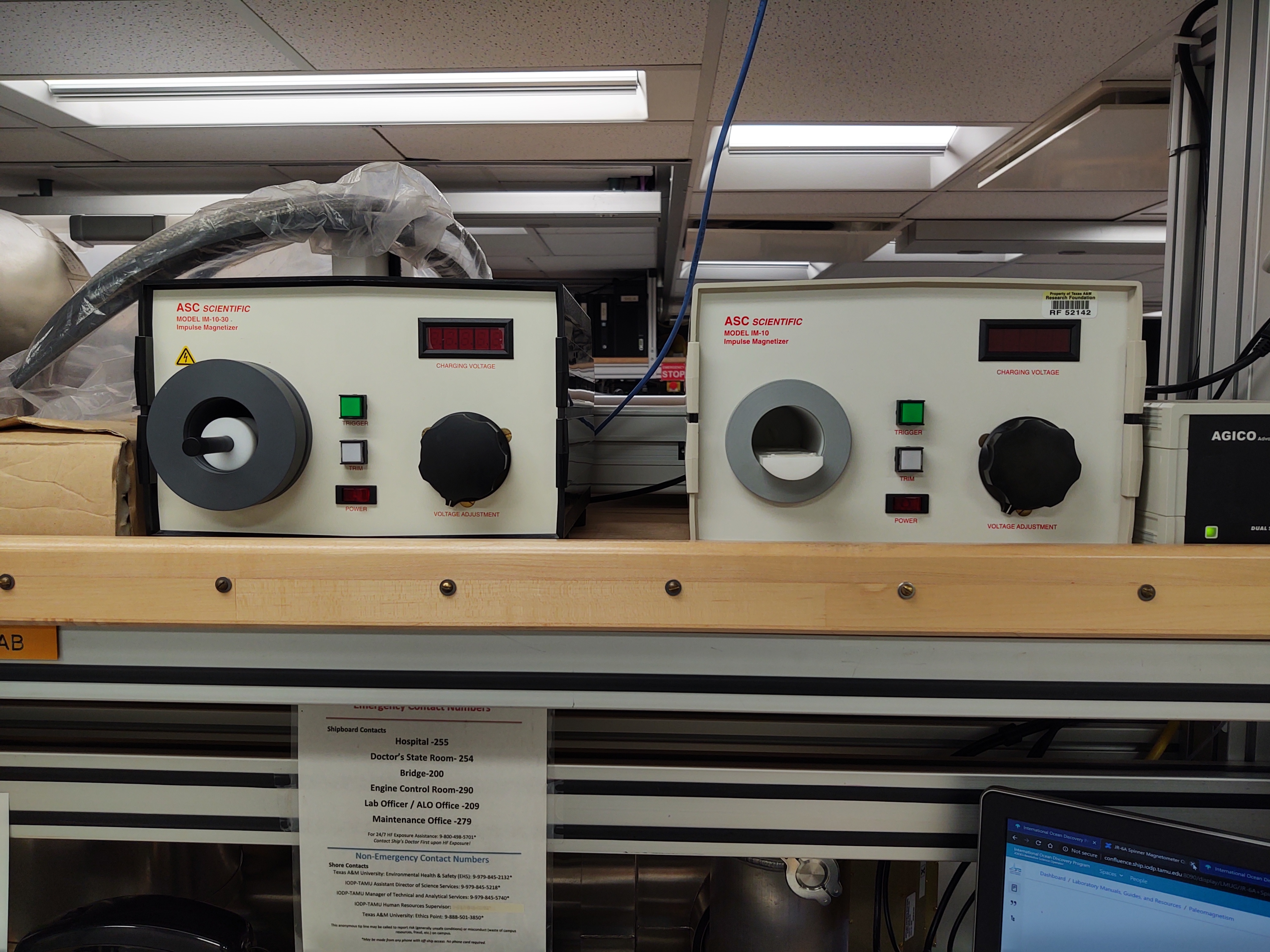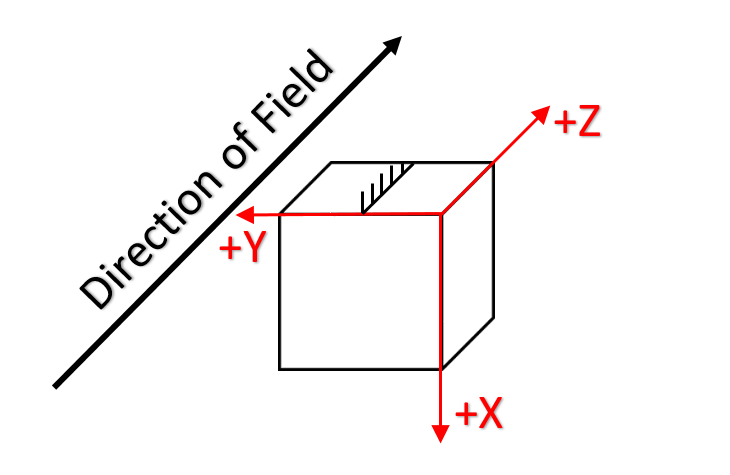
Introduction
This user guide will help scientists and technicians correctly use the ASC Scientific IM10/ IM10-30 Impulse Magnetizers (Figure 1). The ASC Scientific IM10/IM10-30 Impulse Magnetizer (referred to as IM10 and IM10-30) are used to impart an isothermal remanent magnetism (IRM) by exposing the sample to a transient DC magnetic field at a constant temperature (Do we need a note about DC versus AC fields?). The field is produced by the discharge of energy from a capacitor bank through a coil surrounding the sample cavity. The capacitor bank is charged to the desired voltage (corresponding to the desired field) and then discharged through the coil generating a transient DC field to impart an IRM.

Figure 1: ASC Scientific IM10-30 (left) and IM10 (right) Impulse Magnetizers
For a given applied field, the IRM is the remanent magnetization acquired by magnetic grains with a coercive force less than or equal to the applied field. Once the applied field is greater than all of the grains' coercivities, the remanence magnetization reaches a maximum. The field at which the IRM no longer increases with increasing applied field is the saturation field (Hs) and the resulting remanence is called the saturation isothermal remanent magnetization (SIRM). The opposite DC field necessary to reduce the SIRM to zero is the coercivity of remanence (Hcr). Since SIRM, Hcr, and Hs are dependent on both magnetic grain-size and mineralogy, the IM10/10-30 are ideal for primary magnetic carrier identification.
The IM10 and IM10-30 are capable of applying fields up to 1.2 T and 5T, respectively. The desired applied field is set by the charging voltage and controlled by the voltage adjustment knob. The necessary charging voltages for a specific field are factory calibrated and fixed for each coil (given in Appendix A.)
Caution: The magnetizer produces a strong magnetic field capable of re-magnetizing material within 1 m of the coil.
Procedures
- Turn the "Power" switch on. No warm-up period is necessary.
- Place the sample in the holder in the desired orientation.
- Insert the holder into the sample cavity until it hits the back of the cavity.
- Set the voltage adjustment knob so that the ascending voltage approaches the desired charging voltage slowly (displayed on the meter).
- There is a lag time between adjusting the voltage knob and charging of the capacitors to a given voltage (the set voltage is approached asymptotically over a 30- to 60-s time period).
- The most accurate and reproducible results will be obtained if the adjusting knob is set to a point slightly above the desired voltage, so that the desired voltage is approached at a rate of 0.5 V/s.
- Allow the charging voltage to ascend to the desired value and push the trigger button as the voltage reached the desired value. For the most accurate and reproducible results, do not press the trigger button if the voltage is still building rapidly. Caution: Triggering the coil while the voltage is rapidly charging can cause irreversible damage.
- If you overshoot the desired voltage, push the trim button until the displayed voltage drops below the desired value. It may be necessary to hold the trim button down for larger voltage drops.
- Measure the remanent magnetization in the SRM or with the JR-6A. Note: After being magnetized, samples with a high concentration of magnetic minerals may become too strongly magnetized to be measured in the SRM and even by the JR-6A. In this case try a smaller subsample.
- At the end of each work session, turn the voltage adjustment knob fully counterclockwise and trigger the circuit before turning off the power.
Orienting the Samples
Both the IM10 and the IM10-30 produced the field axially along the z axis but in opposite directions.
ASC Scientific IM10 Impulse Magnetizer
The IM10 produces a positive field coming out of the coil towards the user (Figure 2). The orientation of the cube in figure 2 assumes it was taken from the working half. The hatched arrow shown in the following diagrams is the 'up' arrow placed on all cubes during sampling pointing towards the top of the core. The surface with the arrow is the split surface.
Figure 2: ASC IM10 Sample Cube Orientation from Working Half
ASC Scientific IM10-30 Impulse Magnetizer
The IM10-30 produces a positive field going into the coil, away from the user (Figure 3). The orientation of the cube in figure 3 assumes it was taken from the working half. The hatched arrow shown in the following diagrams is the 'up' arrow placed on all cubes during sampling pointing towards the top of the core. The surface with the arrow is the split surface.

Figure 3: ASC IM10-30 Sample Cube Orientation from Working Half
Cleaning
Dust can be very magnetic and since we are imparting IRMs at high fields it is very import to keep the sample cavity clean to prevent magnetic contamination (especially for magnetically weak samples such as carbonates).
- Use a clean rag or paper towel damped with mild cleaning product (e.g. windex) and wipe outwards until clean.
Coil Removal and Installation (IM10-30 only)
The IM10-30 is equipped with 3 interchangeable coils numbered 2 through 4 (Figures 4 and 5). Each coil is unique and has its own charging voltage to desired field table. Charging voltage tables for each coil are presented in Appendix A.

Figure 4: IM10-30 Coils
Figure 5: IM10-30 Coils (front)
Coil Removal
- To remove a coil, unscrew the retaining ring.
- #2 Coil: Insert index and middle fingers of each hand into the sample cavity with your thumbs against the front face of the cavity. Pull the coil straight out.
- #3 Coil: Use the coil extractor tool (Figure 6). Turn the handle of the coil extractor counterclockwise a couple of turns while holding the rubber end. Insert the rubber plug of the extractor into the sample cavity and while pressing it against the side of the cavity, turn the handle clockwise until the plug expands enough to fit snug inside the coil. pull the coil out about 5 cm. Unscrew the handle a few turns until the extractor can easily be removed. Pull the coil straight out.
- #4 Coil: Insert the plastic handle of the extractor slowly into the sample cavity. With a quick jerk, pull the coil out of the cavity about 5 cm. A small finger may also be used to accomplish this. Next, slowly pull the extractor or finger out of the coil and pull the coil straight out.
Figure 6: Coil Extractor Tool
Coil Installation
- Hold the coil with the scribe line on the edge of the front face of the coil pointing up (12 o'clock).
- Push the coil into the cavity on the front panel of the unit until the coil protrudes out of the cavity about 2 cm. Align the scribe line on the coil with the scribe line on the front face of the cavity (Figure 7) and push the coil in the remaining distance until it protrudes by only about 2 mm. Note: A coil inserted with scribe line down will still work but give an IRM in the opposite z direction.
- Screw on the retaining ring until it tightens against the face of the coil. Lightly hand tighten only! You are now ready to use the instrument.
Figure 7: Coil installation
Appendix
A.1 ASC Scientific IM10 Voltage Table
A.2 ASC Scientific IM10-30 Voltage Table
Credits
Text for this document was taken from the Handbook for shipboard paleomagnetists. ODP Tech. Note, 34., 2007